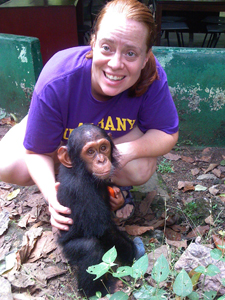- Home
- /
- UAlbany News
- /
- Release
- /
Research by UAlbany Biologist Suggests that Genetics May Provide Clues to Reduce Illegal Chimpanzee Smuggling in Africa
Professor�s research to be published in national journal BMC Ecology
Contact(s): Catherine Herman (518) 956-8150
 |
UAlbany biologist Mary Katherine Gonder compares the genetic sequences of rescued chimpanzees with those of their wild counterparts across several areas of Cameroon and its border with Nigeria to assess whether smuggling is a widespread problem. |
ALBANY, N.Y. (January 22, 2010) -- The population of chimps across Western Africa has decreased by 75 percent in the last 30 years due in part to widespread chimp hunting. Research by University at Albany Biological Sciences Professor Mary Katherine Gonder, in collaboration with the Limbre Wildlife Centre in Cameroon, suggests that genetics may provide valuable clues to help reduce illegal chimpanzee smuggling and safely reintroduce rescued chimps in the wild.
Gonder�s study �Tracing the origins of rescued chimpanzees reveals widespread chimpanzee hunting in Cameroon,� recently published in the journal BMC Ecology, compares the genetic sequences of rescued chimpanzees with those of their wild counterparts across several areas of Cameroon and its border with Nigeria. The goal, said Gonder, was to determine where the rescued chimps came from and assess whether smuggling is a widespread problem or if certain hotspots of exploitation exist in the country.
Gonder and her colleagues obtain DNA from the feces and hair samples of the wild chimpanzees. They followed the unhabituated chimpanzees to nests in trees where the animals sleep and eat. After the nests are abandoned, researchers climbed trees searching for hairs and collected fecal samples from the ground. The samples were preserved and examined at Gonder�s UAlbany lab.
�What we are finding is that all the rescued chimps were from Cameroon, which means that international smuggling seems to be less of a problem than local trade,� said Gonder, who worked closely with UAlbany grad student Lora Ghobrial on the study. �However, the problem seems to occur all across Cameroon, with some rescued chimps even coming from protected areas.�
A smuggler in Eastern Africa can get up to $20,000 for a live chimpanzee on the international black market and around $100 in the local market in Cameroon, she noted. Despite the existence of enforced wildlife protection laws, smugglers often risk the penalties for trafficking chimpanzees, dead or alive.
Chimps are often taken while hunters poach other animals, many of which are also endangered. The new research may help address the wider problem of illegal animal trade by identifying hunting patterns in smuggling routes, said Gonder. It will also help reunite rescued chimpanzees with their relatives in the wild by comparing their genetics and reintroducing them to their natural habitat, she said.
�Since as many as ten chimpanzees are killed for every one that is rescued, we hope this research will have a significant impact on the restoration of the chimpanzee population in Africa,� said Gonder, who is also part of a team of government delegates, local and international scientists developing a conservation action plan for chimps in Cameroon and Nigeria.
At UAlbany, Gonder�s research focuses on reconstructing how evolutionary forces, including genetic mutations and migration, have shaped and maintained genetic variation in contemporary primate populations. Her research in Western Africa is supported by funding from the National Science Foundation.
![]() For more news, subscribe to UAlbany's RSS headline feeds
For more news, subscribe to UAlbany's RSS headline feeds
Educationally and culturally, the University at Albany-SUNY puts "The World Within Reach" for its 18,000 students. An internationally recognized research university with 58 undergraduate majors and 128 graduate degree programs, UAlbany is a leader among all New York State colleges and universities in such diverse fields as public policy, nanotechnology and criminal justice. With a curriculum enhanced by 300 study-abroad opportunities, UAlbany launches great careers. For more information about this globally ranked University, visit www.albany.edu. For UAlbany's extensive roster of faculty experts, visit www.albany.edu/news/experts.shtml.


